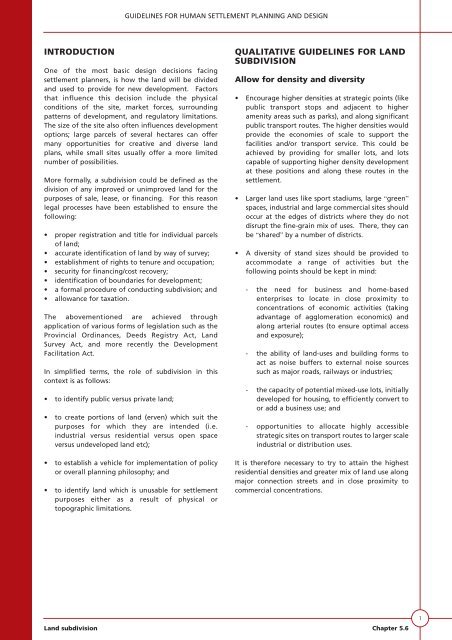VOLUME 1 HUMAN SETTLEMENT PLANNING AND ... - CSIR
VOLUME 1 HUMAN SETTLEMENT PLANNING AND ... - CSIR
VOLUME 1 HUMAN SETTLEMENT PLANNING AND ... - CSIR
- No tags were found...
You also want an ePaper? Increase the reach of your titles
YUMPU automatically turns print PDFs into web optimized ePapers that Google loves.
GUIDELINES FOR <strong>HUMAN</strong> <strong>SETTLEMENT</strong> <strong>PLANNING</strong> <strong>AND</strong> DESIGNINTRODUCTIONOne of the most basic design decisions facingsettlement planners, is how the land will be dividedand used to provide for new development. Factorsthat influence this decision include the physicalconditions of the site, market forces, surroundingpatterns of development, and regulatory limitations.The size of the site also often influences developmentoptions; large parcels of several hectares can offermany opportunities for creative and diverse landplans, while small sites usually offer a more limitednumber of possibilities.More formally, a subdivision could be defined as thedivision of any improved or unimproved land for thepurposes of sale, lease, or financing. For this reasonlegal processes have been established to ensure thefollowing:• proper registration and title for individual parcelsof land;• accurate identification of land by way of survey;• establishment of rights to tenure and occupation;• security for financing/cost recovery;• identification of boundaries for development;• a formal procedure of conducting subdivision; and• allowance for taxation.The abovementioned are achieved throughapplication of various forms of legislation such as theProvincial Ordinances, Deeds Registry Act, LandSurvey Act, and more recently the DevelopmentFacilitation Act.In simplified terms, the role of subdivision in thiscontext is as follows:• to identify public versus private land;• to create portions of land (erven) which suit thepurposes for which they are intended (i.e.industrial versus residential versus open spaceversus undeveloped land etc);• to establish a vehicle for implementation of policyor overall planning philosophy; and• to identify land which is unusable for settlementpurposes either as a result of physical ortopographic limitations.QUALITATIVE GUIDELINES FOR L<strong>AND</strong>SUBDIVISIONAllow for density and diversity• Encourage higher densities at strategic points (likepublic transport stops and adjacent to higheramenity areas such as parks), and along significantpublic transport routes. The higher densities wouldprovide the economies of scale to support thefacilities and/or transport service. This could beachieved by providing for smaller lots, and lotscapable of supporting higher density developmentat these positions and along these routes in thesettlement.• Larger land uses like sport stadiums, large “green”spaces, industrial and large commercial sites shouldoccur at the edges of districts where they do notdisrupt the fine-grain mix of uses. There, they canbe “shared” by a number of districts.• A diversity of stand sizes should be provided toaccommodate a range of activities but thefollowing points should be kept in mind:- the need for business and home-basedenterprises to locate in close proximity toconcentrations of economic activities (takingadvantage of agglomeration economics) andalong arterial routes (to ensure optimal accessand exposure);- the ability of land-uses and building forms toact as noise buffers to external noise sourcessuch as major roads, railways or industries;- the capacity of potential mixed-use lots, initiallydeveloped for housing, to efficiently convert toor add a business use; and- opportunities to allocate highly accessiblestrategic sites on transport routes to larger scaleindustrial or distribution uses.It is therefore necessary to try to attain the highestresidential densities and greater mix of land use alongmajor connection streets and in close proximity tocommercial concentrations.Land subdivision Chapter 5.61
















